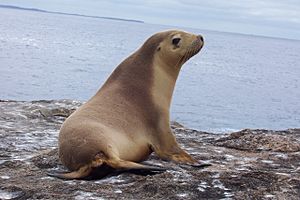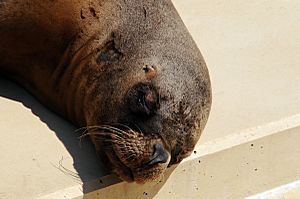Eared seal facts for kids
Quick facts for kids Walrus |
|
|---|---|
 |
|
| An Australian Sea Lion (Neophoca cinerea) | |
| Scientific classification | |
| Kingdom: | |
| Phylum: | |
| Class: | |
| Order: | |
| Suborder: | |
| Superfamily: | |
| Family: |
Otariidae
Gray, 1825
|
An eared seal is a type of marine mammal that belongs to the family Otariidae. These animals are part of a larger group called pinnipeds, which also includes true seals and walruses.
There are 15 different kinds of eared seals alive today, divided into seven groups called genera. You might know them better as sea lions or fur seals. One species of eared seal sadly died out in the 1950s.
Eared seals are special because they live both in the water and on land. They find their food and travel in the ocean, but they come onto land or ice to have their babies and rest. You can find them in cool, mild, and warm waters around the Pacific, Southern, southern Indian, and Atlantic Oceans. However, they are not found in the northern Atlantic Ocean.
The name 'otariid' comes from the Greek word otarion, which means "little ear". This name makes sense because eared seals have small but visible ear flaps. This is one way to tell them apart from true seals, which do not have these ear flaps.
What Eared Seals Look Like
Eared seals have much larger front flippers and stronger chest muscles compared to true seals. This helps them move around. They can also turn their back flippers forward, which lets them walk on all four flippers. This makes them very good at moving on land.
Even though they spend a lot of time in the water, eared seals are thought to be more at home on land. They usually have their babies on land and come out of the water more often than true seals. But in the water, they can swim very fast and are great at turning quickly. They use their strong flippers to push themselves through the water, unlike true seals that wiggle their whole bodies.
You can also tell eared seals apart by their heads, which look a bit like a dog's. They have sharp, strong canine teeth. The teeth behind their canines are usually simple and cone-shaped.
Sea lions have rough, stiff hair covering their bodies. Fur seals, on the other hand, have a thick layer of soft fur underneath their outer hair. This soft fur was once very popular for hunting, which led to many fur seals being hunted in the past.
Male eared seals can be very different in size. The smallest is the Galápagos fur seal, weighing about 70 kilograms (150 pounds). The largest is the Steller sea lion, which can weigh over 1,000 kilograms (2,200 pounds). Male eared seals are usually two to six times heavier than females. They also have much bigger heads, necks, and chests. This big difference in size between males and females is called sexual dimorphism, and it's more noticeable in eared seals than in any other mammal.
Life and Behavior
All eared seals have their babies on land during specific times of the year. Most species gather on beaches or rocky areas, often on islands, every year. The Australian sea lion is an exception, as it has a longer breeding cycle of about 17.5 months.
Eared seals are polygynous, meaning that successful male seals will mate with several females. In most species, the males arrive at the breeding sites first. They set up and protect their areas by making loud noises, showing off, and sometimes fighting. Females usually arrive a day or so before they give birth.
Even though they live in groups, there isn't a fixed leader or social order within the colonies. How much the males control the females or their territories varies among different species. For example, the Northern fur seal and the South American sea lion tend to keep specific females close to them, sometimes even hurting them. But the Steller sea lion and the New Zealand sea lion control their space and generally don't stop females from moving around.
Eared seals are carnivores, which means they eat meat. Their diet includes fish, squid, and krill. Sea lions often hunt closer to the shore in areas where deep, nutrient-rich water rises to the surface. They tend to eat larger fish. Smaller fur seals usually go on longer hunting trips farther out at sea. They can survive by eating many smaller prey items. Eared seals use their eyesight to find food. Some female seals can dive as deep as 400 meters (1,300 feet) to catch their prey.
Types of Eared Seals (Taxonomy)
Here are the different groups and types of eared seals:
- Family Otariidae (Eared seals)
- Genus Arctocephalus (Fur seals)
- Genus Callorhinus
- Northern Fur Seal (Callorhinus ursinus)
- Genus Eumetopias
- Steller Sea Lion or Northern Sea Lion (Eumetopias jubatus)
- Genus Neophoca
- Australian Sea Lion (Neophoca cinerea)
- Genus Otaria
- South American Sea Lion or Southern Sea Lion (Otaria flavescens, formerly Otaria byronia)
- Genus Phocarctos
- New Zealand Sea Lion (Phocarctos hookeri)
- Genus Zalophus
- California Sea Lion (Zalophus californianus)
See also
 In Spanish: Otarios para niños
In Spanish: Otarios para niños




